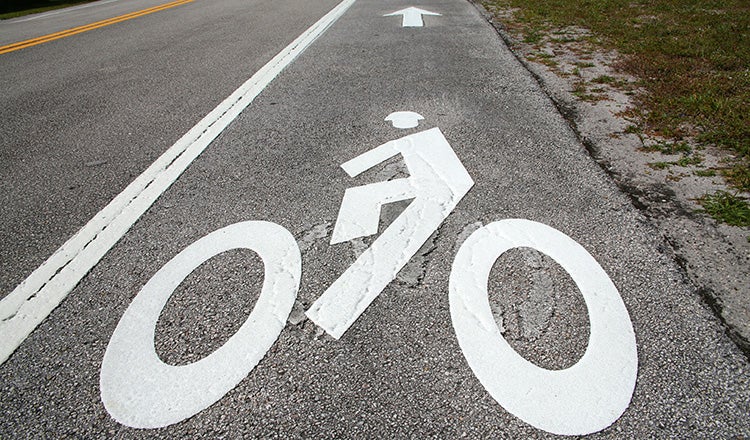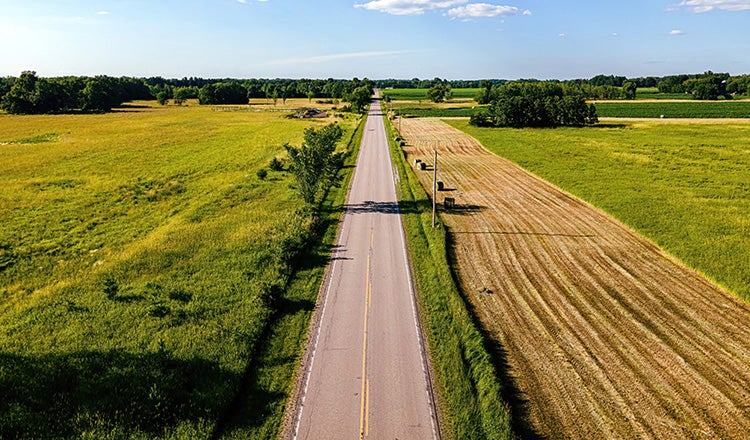
Experts Talk: Exploring Updates to the Highway Safety Manual with Dan Cook
Experts Talk is an interview series with technical leaders from across our transportation program.
American Association of State Highway and Transportation Officials' (AASHTO) Recommended Guidance for More Holistic Roadway Safety Management
The first update to the Highway Safety Manual (HSM) in 15 years is in final review by state transportation agencies around the United States. Expected to be published in late 2025, the HSM2, as the update has been termed, is a comprehensive guidance document for consideration by roadway professionals to evaluate and incorporate traffic safety on road projects. The updates in HSM2 will impact the planning, design and construction of transportation systems for years to come.
HDR Lead Traffic Engineer Dan Cook worked alongside other national experts in roadway safety design and operation on the manual's new version published by AASHTO. Cook’s 15-year career has focused on improving traffic safety and traffic operations analysis, often leading him to participate in national efforts to move the industry forward. He has been a key member of numerous research teams for the National Cooperative Highway Research Program, including work on safety guidelines for highway repairs and freight transportation, as well as predictive methods for improving pedestrian and bicycle safety.
In this interview, Cook discusses key updates in HSM2, explains what they could mean for practitioners and transportation agencies and provides insight into prioritizing future road safety improvements across the U.S.
Q. What is new in the 2nd edition of AASHTO’s Highway Safety Manual?
A. One of the most significant changes is the expansion of the roadway safety management process, described in Part B of the original HSM. HSM2 introduces a systemic approach to safety management as a parallel method to the traditional crash-based approach and outlines the five steps for its application. This advanced guidance shifts from addressing individual high-crash locations to a comprehensive approach that identifies and implements safety countermeasures across an entire road network, targeting risk factors that contribute to serious crashes. Mainstreaming systemic analysis is a game changer. It will help our industry in the same way the medical field was able to progress from treating heart attack patients to proactively managing heart health.
The roadway safety management section of HSM2 also adds an areawide approach, using predictive methods based on macro-level models. This methodology enables practitioners to estimate expected average crash frequencies in geographic regions of various sizes — including block group, census tract, traffic analysis zone, city and county. These evaluations can be used by practitioners for short-term or long-term safety planning or target setting.
Another highly anticipated change focuses on vulnerable road users — including pedestrians, bicyclists and motorcyclists. Prioritizing their safety, the new chapter in Part A addresses factors contributing to pedestrian and bicycle collisions, safety data, indirect safety measures, and integration of pedestrian and bicycle considerations into roadway safety management and predictive methods. It also includes special considerations for school-age children and accessibility for people with disabilities and countermeasures recommendations to reduce work zone crashes. Understanding these factors will improve planning, design and operations decisions.

In Part C of HSM2, the predictive methodology has been expanded with crash prediction models for many new facility types in both urban and rural areas, including roundabouts, intersections with one-way streets, and arterials with six or more lanes. The new manual also introduces new crash prediction models for pedestrians and bicycle collisions, and updates existing models to include predictions for fatal and serious injury crashes for two-lane roadways.
Q. How will the updated Highway Safety Manual impact the planning and design process?
A. The updated highway safety manual is giving us smarter ways to plan, prioritize and design safer roads. It moves us beyond outdated crash rate analysis and toward more reliable methods for spotting safety issues. Instead of using crash rates and observed crash frequencies that can sometimes lead us to fix locations that don’t actually have a problem, HSM2 focuses on methods that are backed by better data and more accurate predictions.
This means we will be able to more effectively identify high-risk areas where safety improvements will make a difference. While the new methods may take more time and resources upfront during planning, they’re worth it if they help save lives and reach our goal of zero deaths on our roads.
The new chapter on the systemic approach to roadway safety management in HSM2 introduces improved ways to find locations that may have previously been overlooked by traditional “hot spot” methods. This could lead to more opportunities to add warning signs, widen shoulders or enhance delineation — small changes that can make a big difference when deployed systemically.
Ultimately, the manual introduces better tools for predicting how geometric design choices, such as lane and shoulder width, affect crashes. That gives engineers more flexibility to design roads that are both safe and cost effective. It also lines up with upcoming changes in the 8th Edition Green Book, which encourages performance-based practical design.
Q. How will the new Highway Safety Manual improve identification of crash locations and expand understanding of safety concerns?
A. The new areawide approach to roadway safety management will be valuable to metropolitan planning organizations, helping transportation leaders better understand the relationship between land development and short-term and long-term safety outcomes. For example, areawide safety performance functions — statistical models using traffic volume and roadway characteristics to assess road safety — can be used to understand the expected change in crash frequency due to major infill development in a city versus development on the outskirts of town on previously undeveloped land.
Guidance in HSM2 will also enable transportation agencies to proactively identify locations on rural highways where crashes are more likely to occur. Approximately half of all serious injuries and fatalities on the road happen in rural areas. Traditionally, practitioners have only focused on high-crash locations to guide safety improvements, but fatalities and serious injuries are often too widely dispersed across the rural transportation system to apply spot treatments. To avoid the fallacy of only responding to fatal crash locations, practitioners will be able to use the systemic method in HSM2 to examine the entire highway system and proactively identify areas that share characteristics with known crash locations. This shift will allow agencies to implement low-cost solutions across the wider road network, delivering high returns on investment and greater overall impact compared to expensive projects at only a few locations.

Additionally, the new crash prediction methods for pedestrian and bicycle collisions will provide guidance to evaluate how design alternatives impact vulnerable road users. For agencies seeking to reconstruct a corridor, new crash prediction methods will predict how many pedestrian and bicycle collisions to expect at the intersections and segments for each alternative. Not only will these findings better measure how safety improvement projects affect the frequency of such collisions, but they will guide decision making on choosing a preferred design that won’t compromise non-motorist safety.
Q. What improvements will we see in safety improvement projects and safety countermeasure selection?
A. A major improvement — mentioned above as part of the roadway safety management process — will be identifying the most suitable locations for further safety analysis by using the new network screening process. This will allow agencies to more effectively allocate funding to projects that reduce crash frequency and severity and improve safety for transportation users.
Another improvement will be enhanced countermeasure selection through the roadway safety management process. This method will identify and manage sites with similar characteristics based on their crash risk, rather than only focusing on crash history. A great example of this is rural two-lane highways, newly added to HSM2. Aiming to reduce dangerous road departure crashes, the systemic approach can identify rural highway segments with contributing factors that correlate with these severe crashes. Agencies can use those findings to guide countermeasure selection, such as shoulder widening, rumble strips or enhanced delineation at these locations.

For pedestrian and bicycle improvements, new prediction models in the network screening process will identify locations most in need of safety countermeasures. From there, practitioners can use updated guidance to choose the best safety solutions, which could be traffic control at midblock crossings or separate bicycle facilities.
Furthermore, HSM2 supports diagnosing safety issues from the road user’s perspective, which in turn leads to more appropriate countermeasure selection. An expanded emphasis on human factors in Part B includes attention and information processing, vision, perception-reaction time and speed choice. We want to provide agencies with enough guidance to avoid selecting safety countermeasures in a vacuum but rather fit into the overall context of the roadway environment while also factoring in the abilities of the transportation users.
Q. What's coming next to help communities, public agencies and highway design professionals improve safety on our roadways and reach our Target Zero goals?
A. Future editions of the HSM will likely integrate more principles of the Safe System Approach (SSA). SSA transforms our approach to thinking about roadway safety, recognizing that humans make mistakes and are vulnerable, and that roadway design should anticipate these mistakes to minimize the chances of serious injuries and roadway deaths. Countries that have implemented SSA have experienced reductions in fatalities and serious injuries on roads. While SSA is still a relatively new concept in the U.S., it aligns with the HSM2 roadway safety management process and predictive methodology’s data-driven approach to designing safer roads.

In the U.S., the Federal Highway Administration has been supporting SSA implementation with methods and tools like the Safe Systems for Intersections methodology. This approach uses kinetic energy models to measure the probability of fatal and serious injuries at intersections between both vehicles and vulnerable road users, shaping design alternatives. The FHWA has also developed a Safe System Roadway Design Hierarchy, a framework to guide transportation agencies and practitioners as they prioritize safety countermeasures and strategies in alignment with SSA. An ongoing NCHRP project is creating a toolkit to support SSA implementation across the transportation life cycle.
Inspiration & Advice
Q. What sparked your interest in roadway safety and design?
A. As a kid, I was always interested in transportation, but it wasn’t until I started working as an undergraduate research assistant that I realized there was a whole world dedicated to transportation safety. The idea of developing solutions — and methods to influence solutions — with a mission of bringing loved ones home safely was one that instantly struck a chord with me and has driven me ever since.
Q. What advice would you give to those considering a career in roadway safety and design?
A. My advice is to take opportunities as they come and make the most of them, even if they aren’t necessarily what you first envision. I graduated college during the great recession and finding a job was difficult. After months of looking, I took the first job I could find, which was not in roadway safety. But it was a great opportunity to learn professional skills and grow my network.
Your career will be full of decisions and different paths, but if you work hard and don't burn bridges, the opportunities will present themselves. Trust the process. And no matter what facet of transportation your career is in, you can make safety part of it. If we are ever going to eliminate traffic fatalities, it is going to have to be an all-in effort by everybody.
Each Experts Talk interview illuminates a different aspect of transportation infrastructure planning, design and delivery. Check back regularly to discover new insights from the specialized experts and thought leaders behind our award-winning, full service consulting practice.


